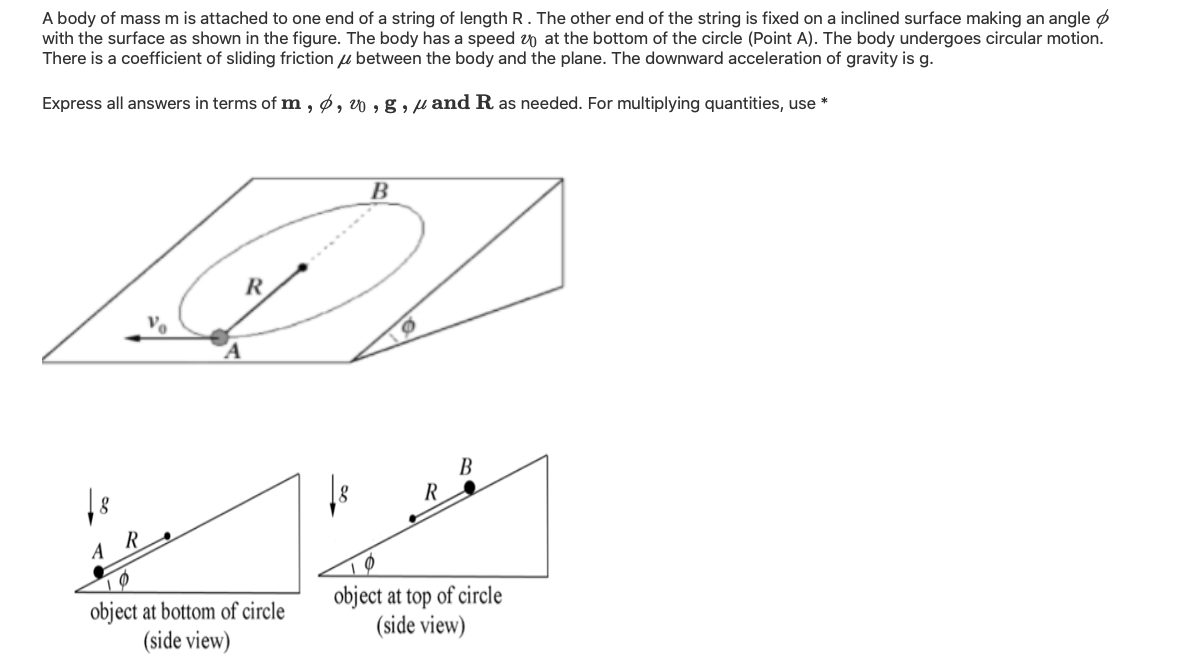A body of mass m is attached to one end of a string of length R. The other end of the string is fixed on a inclined surface making an angle ø with the surface as shown in the figure. The body has a speed vp at the bottom of the circle (Point A). The body undergoes circular motion. There is a coefficient of sliding friction u between the body and the plane. The downward acceleration of gravity is g. Express all answers in terms of m , ø, w , g,µand R as needed. For multiplying quantities, use *
A body of mass m is attached to one end of a string of length R. The other end of the string is fixed on a inclined surface making an angle ø with the surface as shown in the figure. The body has a speed vp at the bottom of the circle (Point A). The body undergoes circular motion. There is a coefficient of sliding friction u between the body and the plane. The downward acceleration of gravity is g. Express all answers in terms of m , ø, w , g,µand R as needed. For multiplying quantities, use *
Principles of Physics: A Calculus-Based Text
5th Edition
ISBN:9781133104261
Author:Raymond A. Serway, John W. Jewett
Publisher:Raymond A. Serway, John W. Jewett
Chapter11: Gravity, Planetary Orbits, And The Hydrogen Atom
Section: Chapter Questions
Problem 46P
Related questions
Question
What is the tension in the string when it reaches point B.

Transcribed Image Text:A body of massm is attached to one end of a string of length R. The other end of the string is fixed on a inclined surface making an angle ø
with the surface as shown in the figure. The body has a speed p at the bottom of the circle (Point A). The body undergoes circular motion.
There is a coefficient of sliding friction u between the body and the plane. The downward acceleration of gravity is g.
Express all answers in terms of m , ø, w , g , u and R as needed. For multiplying quantities, use *
R.
B
18
A
R
object at bottom of circle
(side view)
object at top of circle
(side view)
![Part a How much work does the friction force do on the body as it moves from the bottom of the circle (point A) to the top of the
circle (point B)?
Write your answer using some or all of the following: phi for ø, v_0 for 0, phi for ø, mu for u and cos() for cosine. [Notice, In case of math
umg cos(ø)
R
expression you need to be precise. For example, if your answer is
', you need to write it as mu*m*g*cos(phi)/R.]](/v2/_next/image?url=https%3A%2F%2Fcontent.bartleby.com%2Fqna-images%2Fquestion%2Fce0060ff-4d7e-4125-a5ff-63ad9cd04436%2Ff1b18645-0b1f-4a89-93e3-4db00b04348b%2F429tarl_processed.png&w=3840&q=75)
Transcribed Image Text:Part a How much work does the friction force do on the body as it moves from the bottom of the circle (point A) to the top of the
circle (point B)?
Write your answer using some or all of the following: phi for ø, v_0 for 0, phi for ø, mu for u and cos() for cosine. [Notice, In case of math
umg cos(ø)
R
expression you need to be precise. For example, if your answer is
', you need to write it as mu*m*g*cos(phi)/R.]
Expert Solution
This question has been solved!
Explore an expertly crafted, step-by-step solution for a thorough understanding of key concepts.
This is a popular solution!
Trending now
This is a popular solution!
Step by step
Solved in 2 steps with 2 images

Knowledge Booster
Learn more about
Need a deep-dive on the concept behind this application? Look no further. Learn more about this topic, physics and related others by exploring similar questions and additional content below.Recommended textbooks for you

Principles of Physics: A Calculus-Based Text
Physics
ISBN:
9781133104261
Author:
Raymond A. Serway, John W. Jewett
Publisher:
Cengage Learning

Classical Dynamics of Particles and Systems
Physics
ISBN:
9780534408961
Author:
Stephen T. Thornton, Jerry B. Marion
Publisher:
Cengage Learning

Principles of Physics: A Calculus-Based Text
Physics
ISBN:
9781133104261
Author:
Raymond A. Serway, John W. Jewett
Publisher:
Cengage Learning

Classical Dynamics of Particles and Systems
Physics
ISBN:
9780534408961
Author:
Stephen T. Thornton, Jerry B. Marion
Publisher:
Cengage Learning